
St. Lucia Parrot.
Awoken by the light and warmth of the sun, I could muster little more than to roll over, push the curtains aside, and look at the tiny brown bird sitting on the fence. My lifer Barbados Bullfinch! Jeannette staggered to the window to glimpse it as well. We then went back to sleep for a couple more hours.
Those extra two hours did little to alleviate our exhaustion, but hey, at least we saw our bullfinch! The only endemic landbird on Barbados (as well as an endemic subspecies of Carib Grackle, which we also saw out the window), this was the reason for our layover here. A layover that was supposed to be 24 hours, including some time to explore and a get a full night’s rest. Instead, we had 10 hours on the island. And by the time we finally got out of bed for real, it was only about 5 hours – and that included getting to and waiting at the airport.
See, our trip from Maine was anything but smooth. During the second half of the Super Bowl, our early am flight from Portland to JFK in New York was cancelled, and everything was re-booked for two full days later. That was not going to work. So Jeannette spent the better part of the half on hold, and eventually getting us on a flight the next afternoon, and rebooking our JFK-Barbados flight.
Jet Blue ostensibly cancelled that early am flight due to weather, but that was complete B.S. There was nothing more than some wet snow at JFK that next morning, and snow didn’t reach Maine until after noon. There would not have been any interference with that 5:20am flight.
But there was a storm coming, so we were worried about our 3:10pm flight out of Portland. Instead of chancing it, we took the 6:30am Concord Trailways bus from New York City (a newer service, under better circumstances, this was actually a very pleasant experience and one we would consider again…especially at only $69 per person each way). 6 hours later, we walked a mile to a subway station for the E train, and took the E to the Airtrain. While on the Airtrain, a text message alerted us to the arrival of our original flight to Barbados. Salt in the wounds. Moments later, the Airtrain was evacuated when someone left a bag on board.
Finally arriving at the airport, we had 8 hours to explore. 8 hours is a lot in an airport terminal. Anyway, at least we were there, and our 9:30 pm flight out of JFK left with only a minor delay, and we were on our way.
We arrived on Barbados at 3:30am, cleared customs, and then got a cab to our Christ Church guesthouse where we were supposed to spend the night. We had alerted them to our delay, but when our cab dropped us off and sped away, no one was to be found. We knocked, and knocked some more, and finally got someone to pick up the phone. We crawled into our room at about 5:00am.
It was about 7:30 when I looked out the window, and by the time we made it outside (sans coffee, so it was really a struggle! And thank goodness we travel with Cliff Bars) we had just little more than an hour to wander. But Barbados Bullfinch was as common and conspicuous as promised, and so were the grackles. And Bananaquits – one of our favorite birds in the world.
A short walk fueled by a Coca-Cola from a little shop provided just a glimpse into the island’s town avifauna, such as zippy Black-faced Grassquits, stunning Green-throated Caribs, and ubiquitous Gray Kingbirds.
 Our Barbados guest house.
Our Barbados guest house.
 With bullfinch habitat right out the door.
With bullfinch habitat right out the door.
 Caribbean Elaenia
Caribbean Elaenia

Barbados Bullfinch.
 Green-throated Carib.
Green-throated Carib.
 Carib Grackle
Carib Grackle
 View of Kingstown from Grenadine Hotel.
View of Kingstown from Grenadine Hotel.
But before we knew it, we were back at the airport. 40 minutes after departure we were back on the ground – and back on schedule – in St. Vincent, the first of our two primary destinations of our trip. We were kinda awake on the cab ride to our hotel, the Grenadine House, on the outskirts of Kingstown. An early dinner, and then early to bed. It was a much needed night of rest.
Unfortunately, we had another snafu, as our birding guide for the day had to postpone because the truck she was going to be using for the day broke down. Luckily, we had two full days on the island, so we just rescheduled for the next day.
This turned out to work to our advantage, as we awoke to pouring rain in the morning. Once again, we went back to bed.
Finally revived, we took a walk to the nearby botanical gardens. We were finally birding for real (read: awake), and enjoyed reacquainting ourselves with some of the common birds of the region, including Grenada Flycatcher, Antillean Crested Hummingbird, and Scaly-naped Pigeons. And the spiffy all-black St. Vincent race of the Bananaquit – one of our favorite birds just got even better!
The afternoon was spent wandering the markets and shops of Kingstown, adding a few species to our fledgling island list along the waterfront, such as migrant Barn Swallows and resident Brown Boobies and Magnificent Frigatebirds.

 Cannonball Tree flower.
Cannonball Tree flower.
 St. Vincent Bananaquit.
St. Vincent Bananaquit.
 Gray Kingbird
Gray Kingbird
 St. Vincent Parrot captive breeding program.
St. Vincent Parrot captive breeding program.

Day 3, 2/11:
Lystra Culzac-Wilson (one of the island’s two birding guides) picked us up early in the morning, and by 6:00 we were already on the trail. Shortly after sunrise, from an overlook, we had spotted our quarry: St. Vincent Parrots! At least 15 in all, with pairs and family groups (pairs plus a youngster from the previous year) squawking from nearby hillsides, flying from ridge to ridge, and feeding in trees across the valley. It was cloudy, and the light was still low, and most of the birds were far, so photography was a challenge.
However, Jeannette managed a couple of shots of a close fly-over, and we did enjoy great views as the birds flew around. Wow. What a bird! (Yeah, I know, our pictures don’t do it justice.)
Moseying along the nearby Vermont Nature Trail, Purple-throated Caribs were our next lifer – big, gorgeous, stunning hummers. The endemic subspecies of House Wren finally showed itself, and we saw regional endemics like Lesser Antillean Bullfinch and Lesser Antillean Tanager for the first time since we visited Grenada 7 years ago.
But the endemic and Endangered Whistling Warbler eluded us, so we were off to the other side of the island to search for it. On some seemingly-random trail (accessed by crossing some farm fields and cattle pasture) in the Montreal area (yes, we traveled from Vermont to Montreal, but had to pass through Mesopotamia to do it!), we hiked up yet more stairs (there are a lot of stairs on trails in St. Vincent, we found) and after quite some effort, Lystra whistled a Whistling Warbler into our vicinity, and after a couple of glimpses, I was treated to a stunning view as this shy little bird popped out in the open for a moment just where I happened to be looking. Unfortunately, Jeannette wasn’t looking in the same exact place, so she only caught a fleeting glimpse. Lystra worked hard for us though.
Our lifer Brown Tremblers a’ trembling were anything but fleeting, as near the bottom of the trail three birds put on quite a show. The “chocolate thrasher-wren” was one of our most-wanted non-endemics (but limited to the Lesser Antilles) of the trip, so it was nice to get a good show.

 St. Vincent Parrots!
St. Vincent Parrots!


Day 4, 2/12.
Since Jeannette wasn’t completely satisfied with her Whistling Warbler, we decided to try again at the Vermont Nature Trail. We glimpsed a few more parrots, had some better looks at Purple-throated Carib, but unfortunately only heard a single Whistling Warbler. We knew it was time to give up when several busloads of cruise ship passengers arrived on the trail, quite a few clearly out of their element and voicing their displeasure about things like steps, mud, and the pleasantly few mosquitoes.
Back in Kingstown, we finally twitched some delectable curried goat at Stoplight 2 restaurant, on Lystra’s recommendation. As you know, food is second only to birds when we travel, and it’s a local place off the tourist route (well, what there was for a tourist route here) that we love to find.
Also, unlike most tourists, we prefer mass transit, and although we did need a cab to get to the Vermont Trail in the morning, the afternoon was spent traveling strictly by mini-bus. Cheap, easy, a great way to see the towns, meet the people, and especially here (as in Grenada), listen to some local beats.
A short trip to Villa Beach was a change of scenery from the rainforest, and added several birds to our paltry island list, including Royal Tern, Brown Pelican, Osprey, and Belted Kingfisher. A walk into the village of Villa Flat added Tropical Mockingbird, and since we were on the island’s dry side, most of the Bananaquits had yellow-bellies. Undoubtedly, the extra melanin was a benefit in the wet environs, where it likely helps protect the feathers from mold or lice or something.
The Friday afternoon-evening streets of Kingstown were hopping, so after a couple more Harouns (the local endemic lager), we foraged for dinner, finding a great little barbeque stand near the harbor, where we enjoyed a little local flavor – both food wise and conversation. Actually, talking with the grillmaster was a lot of fun and provided that view into local life that you don’t get at a sterilized resort. I do think we were officially “liming,” which is an art form of relaxation and conversation that is practiced like a religion in the Caribbean. Oh yeah, and the BBQ pork was outstanding – perfectly succulent, tender, and the sauce hit every note.


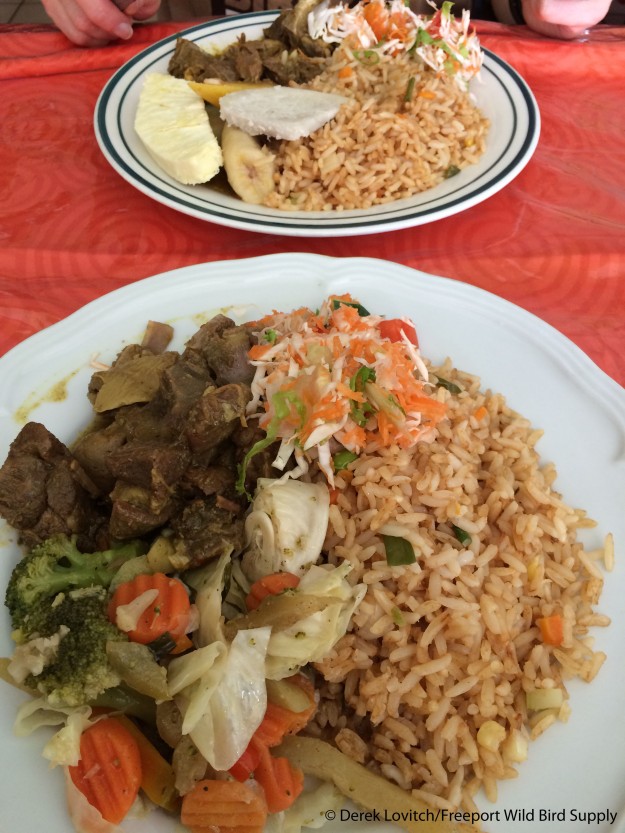 Curried Goat at Stoplight2 Restaurant.
Curried Goat at Stoplight2 Restaurant.
 Villa Beach
Villa Beach

 Kingstown BBQ
Kingstown BBQ
Day 5, 2/13.
We felt our return to the Vermont Nature Trail the prior day in the hopes of improving Jeannette’s view of the Whistling Warbler precluded exploration of more of the island and its habitats. However, despite the temptation to go further afield, we decided to take it easy (despite having also missed the endemic subspecies of Brown-throated Solitaire which apparently had not yet begun to sing; we never heard a peep from a single one while in the forest), and just return to the Botanical Gardens, a short walk away, for some relaxed birding and photography.
A single Little Blue Heron was the only “new” bird for us (our 38th species on the island), but we had great looks at all of the local flycatchers, including Yellow-bellied Eleanias and Grenada Flycatcher. We were also very surprised to spot a Lesser Antillean Tanager so low, and at the back of the gardens, we flushed a hunting Common Black-hawk, which also came as a surprise to us at the outskirts of the city.
We then went into town for lunch once again (the food at the Grenadine House was quite good, but as usual, we prefer to be even more local in our dining). Our disappointment that our new BBQ friend wasn’t open yet was alleviated when I turned on my “food-dar” and found a fried chicken stand down a waterfront alley, which turned out to be the best piece of fried chicken we have ever had. It was thoroughly coated with what tasted like more spices than flour, and each bite was packed with flavor.
We really could have used another day on the island, but once again, we were back at an airport, and this time, we were heading to St. Lucia. Rich (for its size) in endemics, and with an impressive conservation ethic (compared to most of the region), this island has always been very high on my list. And it did not disappoint.
Our hour-long taxi ride crossed through the middle of the island, and deposited us at our quaint and quiet little guesthouse, Peace of Paradise (aka “Lorraine’s’). Lesser Antillean Bullfinches, Antillean Crested Hummingbirds, and Bananaquits (100% yellow-bellied on this island) greeted us, which were more welcome than whom we shared our bedroom with(The next day we learned that Sun Spiders were completely harmless. Nonetheless, we were thankful for the bug netting over the bed at night…even if I may have become a bit ensnared in it as I stumbled to the restroom in the middle of the night).

 Black-faced Grassquit
Black-faced Grassquit
 Grenada Flycatcher.
Grenada Flycatcher.
 Best fried chicken ever!
Best fried chicken ever!

 “Lorraine’s” Peace of Paradise, St. Lucia.
“Lorraine’s” Peace of Paradise, St. Lucia.
 Our bedroom Sun Spider.
Our bedroom Sun Spider.
Day 6, 2/14:
With a larger roster of endemics, and with two sides of the island to seek them on, we hired local birding guides for two days to hedge the bet. While we can’t really afford to hire a guide for every day of a trip, we also wouldn’t really want to as we like to also learn and explore on our own. However, we ALWAYS hire local guides for a day or two, for several reasons.
Obviously, they are LOCAL and therefore know the spots better than reading someone’s trip report <ahem>. We certainly could have gotten to the Vermont Nature Trail on St. Vincent without Lystra, but we could never have known the best places to stop and the prime patches to search. We also never would have found that back-up trail near Montreal (nor did I have any interest in renting a car and taking on those roads!). We want to see these endemics, and we never want to leave feeling we “need” to come back (wanting to come back is another story) because we missed something. We also want to learn more about the birds, the habitat, the plants and animals, the places to eat lunch, and what life is really like in the places we visit. Some of our best experiences with guides haven’t even been about the birds, such as eating street food in Port of Spain, Trinidad or getting a tour of our guide’s mother’s garden in Grenada.
Most importantly, however, after we leave, these guides are the ones who will make sure these birds exist for the next visitor. Protecting the birds and places they love, and that provide the income for them and their families, are how these special places and special species will have a chance to survive. Without supporting the local economy, too many of the remaining natural areas we want to protect will fall to development, agriculture, and other ways for an economy to be developed or sustained.
St. Lucia has a great infrastructure (much wider and safer-seeming roads than we saw on St. Vincent, for example) to get around, and it wasn’t hard to discover online that the Des Cartier Rainforest Trail was the place to go. Nonetheless, we looked forward to our time there with our local guide and dark and early (checking clothes and footwear for snoozing Sun Spiders), we met our guide, Vision, who, along with Adams (who we would spend time with the next day), make up Wildlife Ambassadors, the upstart nature tour company of the island.
Our first stop was in fact the Des Cartier trail, and it wasn’t long before Vision pointed out our first St. Lucian endemic (and one of the more challenging and endangered ones), the St. Lucia Black Finch.
And that’s when our life list really began to blossom (at least from an island), as in rapid succession, we added St. Lucia Oriole, Antillean Euphonia, St. Lucia Parrot, Pearly-eyed Thrasher, Scaly-breasted Thrasher, Lesser Antillean Flycatcher, and St. Lucia Pewee (split by most everyone except the AOU). And unlike on St. Vincent, we lucked into some great views and photo opportunities of the local parrot.
Our luck continued with great views of two more lifers, Rufous-throated Solitaire and St. Lucia Warbler. The song of the solitaire was other-worldly, and the charismatic (and common) little warbler would become one of our favorite birds of the trip.
Earlier, I mentioned how local guides are so important for conservation, and after we exited the forest, our next stop was a perfect example of this. The Aupicot Wetlands was an old coconut estate that the local guides have gained access to and are working to protect. With future plans for an ecotourism destination of some sort, for now, they have got the local landowners to reduce the impact of local fisherman and protect the habitat. And because of this effort, it was teeming with birdlife, even though a very dry season was quickly drying out the shallow pond. Migrant Greater and Lesser Yellowlegs and Semipalmated Plovers were joined by migrant Blue-winged Teal and American Wigeons. Great and Snowy Egrets and Little Blue Herons were joined by single Green and Great Blue Herons, and we identified a spiffy Little Egret among the flock. A couple of Common Gallinules joined a little “cover” of coots – both resident the-species-formerly-known-until-very-recently-as-Carribean-Coots and presumed migrant, small-shielded “American” American Coots.
After a check of some of the environs around the Hewanorra International Airport (migrant Solitary Sandpipers and some of the only Eared Doves on the island), we dined on chicken curry and chicken pelau among Carib Grackles on the beach at The Reef Beach Café.
Next up was the southern tip of the island, with the second highest lighthouse in the world. More importantly, however, there were Red-billed Tropicbirds below.
Back in Prasline, Vision had one more trick up his sleeve, eventually pulling out our lifer Endangered White-breasted Thrasher from some roadside scrub, along with a couple of Lesser Antillean Saltators – our 12th lifer of the day!
 St. Lucia Parrot pair.
St. Lucia Parrot pair.
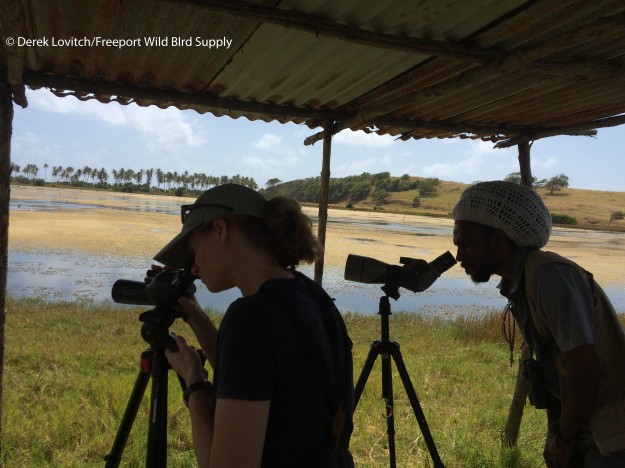
 Little Egret, Aupicot Wetlands.
Little Egret, Aupicot Wetlands.


Day 7, 2/15:
We really cleaned up the day before, but we had a few more birds to search for – and more of “someone else doing the work” – as Vision picked us up dark and early for a drive to the island’s northeastern side. There, we met up with his colleague, Adams, and three other visiting birders from the States to pile into one high-clearance, 4WD vehicle for the rough and treacherous road to dry native forest in Grand Anse.
A most fruitful Mango tree (pun intended!) yielded our next lifer, the Gray Trembler, plus better looks at St. Lucia Oriole and several Lesser Antillean Saltators. The forest yielded oodles of St. Lucia Warblers, at least two pairs of St. Lucia Black Finches, a whopping 7+ White-breasted Thrashers, and a pair of ultra-cooperative Lesser Antillean Flycatchers.
Bridled Quail-Doves were giving us fits though, as this shy and reclusive bird was not making it easy for us. Adams worked hard, and we stalked at least 5 different birds. Mostly, they were glimpsed by one or two people as they flew across a gully or flushed straight away. Eventually, I saw one (in flight) well enough to count, but Jeannette was still looking for more than a shadow. I had a decent look at one on the ground as we returned to the vehicle and Vision (rejoining us after a quick vehicle repair) spotted one, but Jeannette is still waiting for her satisfactory view.
Back up the hill and in Vision’s roomy van, the group headed towards the water, arriving at Pigeon Island National Landmark. We ate chicken rotis as we watched Royal Terns and Brown Boobies.
At Gros Islet Bay, Vision was excited to point out the first island record of Great Black-backed Gull, a 1st winter bird that he found here in December. While there was some disagreement over its identification, he and Adams had become convinced by a visiting birder that it was in fact a Great Black-backed Gull. Just on a quick impression of overall shape and size, I thought otherwise, so we pulled around for a closer view.
And as I suspected, it was a Lesser Black-backed Gull, and an impromptu gull workshop explained why. I felt bad, however, as I was afraid I had burst the bubble of a rarity, and I took a lifer off my guide’s list. But then Vision assured me it was quite alright – Lesser Black-backed Gull was also a first record for the island and a life bird for himself! (I’ll be submitting a write-up to Vision, Adams, and the regional editor for North American Birds, so feel free to shoot me an email if you too would like a copy of the report)
Sandwich Terns and a handful of Ruddy Turnstones were new for our triplist, and we finished up with yet another high-note: an urban Cattle Egret rookery teaming with adults, juveniles, and sprinkled with Snowy Egrets, a family of Common Gallinules, and a confiding Green Heron (hmm… I think I know which hotel, and which rooms, we want to stay at next time!).
Vision dropped us off at our final lodging of the trip (speaking of ending on a high note), Fond Doux Plantation and Resort. A heavily-vegetated eco-lodge with its own cocoa plantation (and fruit trees, and garden that provided much of the food for the restaurant), we were surrounded by Scaly-breasted Thrashers and hummingbirds in our little cottage. Yup, we were definitely on vacation now!

 St. Lucia Oriole
St. Lucia Oriole
 St. Lucia Warbler.
St. Lucia Warbler.
 White-breasted Thrasher
White-breasted Thrasher
 Lesser Antillean Flycatcher
Lesser Antillean Flycatcher
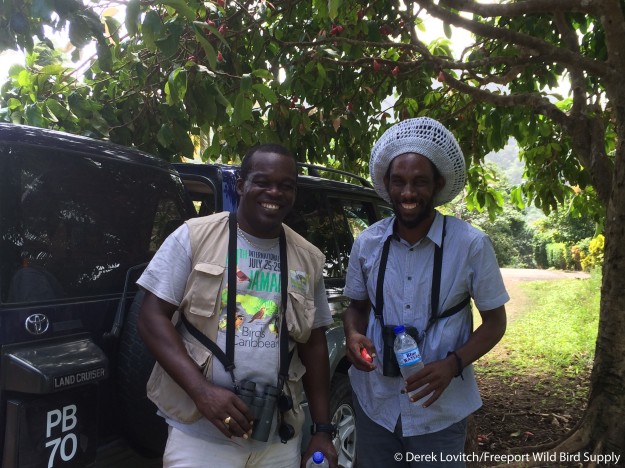 Adams and Vision.
Adams and Vision.


Lesser Black-backed Gull, 1st St. Lucia Record!
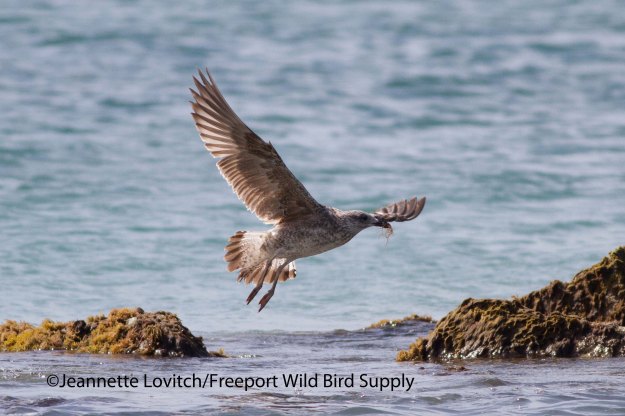

 Juvenile Black-crowned Night-Heron.
Juvenile Black-crowned Night-Heron.
 Green Heron.
Green Heron.
 Cattle Egrets.
Cattle Egrets.

Day 8, 2/16.
Jeannette out did herself finding this place, as it was a real birder’s paradise (without trying). A St. Lucia Oriole surprised us on a pre-breakfast walk, and at breakfast, we were joined by dining Lesser Antillean Bullfinches. Two bold pairs not only picked up scraps, but they also foraged on the table while we were eating. One even landed on Jeannette’s water glass and took a sip!
This was pretty awesome, and the biologists in us had to have some fun, too, so we conducted a little “food preference study,” a video of which we posted to our store’s Facebook page.
After a long and educational breakfast full of lots of fresh fruit and good coffee (finally!), we decided to explore the island by mini-bus. We took the bus from Fond Doux into the town of Soufriere, then got a connection to the big city of Castries.
Small city parks hosted Zenaida Doves, Carib Grackles, Rock Pigeons, Gray Kingbirds, Shiny Cowbirds, Black-faced Grassquits, Bananaquits, and American Kestrels, while walking the path along the harbor yielded Snowy Egrets and Little Blue Herons, Magnificent Frigatebirds, and a couple more Green-throated Caribs. But after lunch, some shopping for spices, hot sauce, and a couple of souvenirs, we had enough of city life (and crowds of cruise ship passengers) and took the bus back to the quieter town of Soufriere.
Laughing Gulls (our first of the trip) were right where Vision told us they would be, and bacon-wrapped fried plantains at Petit Peak restaurant which we enjoyed with a couple of afternoon Pitons (the endemic beer) need to become “a thing.” Also, you couldn’t beat the view of Petit Piton for the enjoyment of your Piton beer.
After a little walk, we decided to have dinner at Water Front De Belle View because I wanted some more curried goat and I was desperate for a good callaloo soup (the one at Fond Doux was just too salty). I wholeheartedly recommend both here.
We grabbed one of the last mini-buses back to Fond Doux, and called it a night.

 Female (top) and Male (bottom) Lesser Antillean Bullfinches joining us for breakfast.
Female (top) and Male (bottom) Lesser Antillean Bullfinches joining us for breakfast.
 Scaly-breasted Pigeon.
Scaly-breasted Pigeon.
 Castries.
Castries.
Day 9, 2/17.
We squeezed in a little more birding by hopping on the bus and taking it uphill from Soufriere to the Bouton Gap. A short, but steep and muddy hike brought us to a series of small overlooks and passed through some productive edge habitat.
We were out in search of our last likely lifer of the trip, Lesser Antillean Swift, but with frequent downpours and low clouds, we were not holding out much hope for high-flying aerial insectivores. So we were forced to content ourselves with a couple of looks at fly-by St. Lucia Parrots, lots of St. Lucia Warblers, cooperative St. Lucia Pewees, and our best view yet of a Pearly-eyed Thrasher. And then, between a break in the rain, several dozen swifts were on the move, heading into the valley below, affording us very good views from above and below. It was my 20th lifer of the trip (19 for Jeannette and she remained unsatisfied with her quail-dove shadows).
We found some great vegetarian Jamaican-style patties from a food truck on the streets of Soufriere, before we hopped on a bus once again for the short ride back to Fond Doux. There, we finally took the plantation tour that we have been trying to find time (or lack of heavy rain) for, enjoyed some good views and nice looks at Purple-throated Caribs, St. Lucia Warblers, and another Pearly-eyed Thrasher. The grounds turned out to be more extensive, and with more less-disturbed forest than we thought, so had we a little more time, no doubt we could have picked up a few more “yard birds” of note.
Our last night of vacation, it was time for our splurge dinner, and so we headed over to Boucan Resort – “the chocolate hotel” – where everything on the menu of their fine restaurant had cacao incorporated in it some way. Sometimes themes like this come across as gimmicky and forced, but that was most definitely not the case here. From the cocktails to the amuse bouche to each entrée – and of course, dessert! – were incredibly well-conceived and perfectly executed. In fact, when all was said and done, Jeannette and I both agreed it was one of the top 3 or 5 meals we have ever had. Anywhere. So yeah, good way to finish a trip!


 Antillean Crested Hummingbird
Antillean Crested Hummingbird
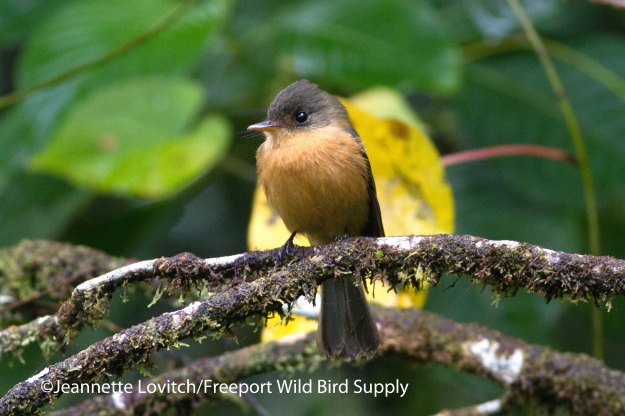 St. Lucia Pewee.
St. Lucia Pewee.
 Antillean Crested Hummingbird
Antillean Crested Hummingbird
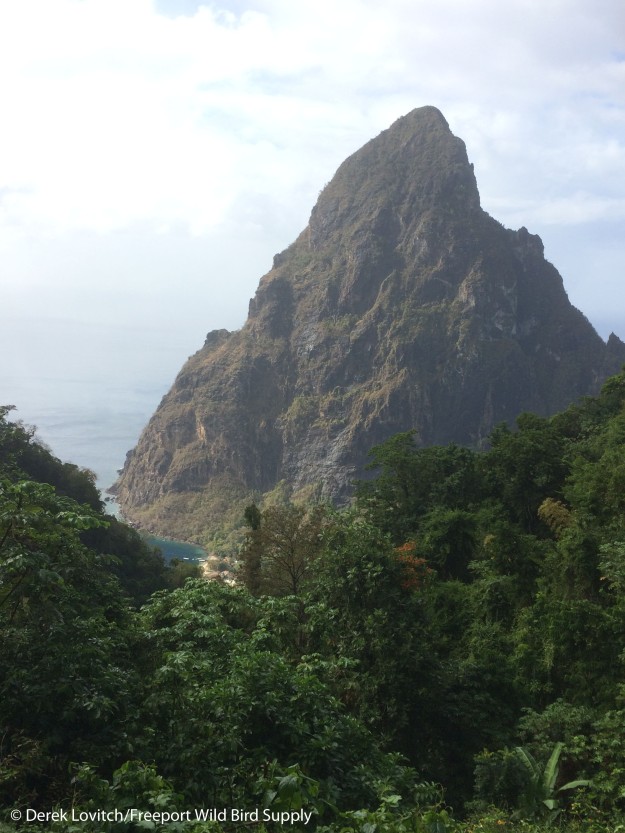
 Our cottage at Fond Doux.
Our cottage at Fond Doux.
 Purple-throated Carib
Purple-throated Carib
 Dinner at Boucan.
Dinner at Boucan.
Day 10, 2/18.
We awoke to heavy rain, and rain that didn’t quite let up as quickly as we would have liked. Therefore, we dallied a bit, fed more bullfinches at breakfast, and eventually had a break in the rain to walk up a nearby side road towards a Nature Trail that was recommended for its birding, and especially its views of the two Pitons. A Gray Trembler, lots of St. Lucia Warblers, and a couple of good looks at Mangrove Cuckoos suggested we probably should have done this sooner as well. In fact, the birding was good enough, and combined with waiting out a few downpours under trees, we made it to the entrance of the trail just as we had to turn around.
Jeannette worked on photographing Antillean Crested Hummingbirds and both Green-throated and Purple-throated Caribs from the porch of the office at Fond Doux as we waited for Adams, who surprised us with an offer of a ride to the airport in exchange for a discussion about developing their ecotourism business. With the third employee now on board, Wildlife Ambassadors has the potential to become a force in birding and nature tourism on the island, and this could be a very good thing for birds and bird conservation here. The Aupicot Wetlands and their protection is a perfect example, as both resident and migratory birds (including some of “our” birds from North America) are rapidly losing safe refugia in the Lesser Antilles. Even better, unlike some islands, they don’t shoot everything that lands here.
We were happy to add our limited travel dollars to the cause – money will talk; when these places are financially worth protecting, they are much, much easier to protect – but also happy to offer some advice and suggestions on everything from websites and Facebook, to tour amenities. We certainly wish Adams and Vision well, and look forward to keeping in touch and seeing what they accomplish in the future.
We also made a quick stop to see if any Grassland Yellow-finches were present near the airport, squeezing in a few more minutes of birding before we began the long trip home. But alas, it was smooth and easy, and nothing like our trip south!
 Scaly-breasted Thrasher.
Scaly-breasted Thrasher.
 Fond Doux. At least I finally looked at the pool!
Fond Doux. At least I finally looked at the pool!
 Green-throated Carib
Green-throated Carib
 Purple-throated Carib.
Purple-throated Carib.
Trip/Island List (* life bird).
Barbados:
- Barbados Bullfinch*
- Zenaida Dove
- Carib Grackle
- Eurasian Collared-Dove
- Black-faced Grassquit
- Cattle Egret
- Caribbean Elaenia
- Bananaquit
- Shiny Cowbird
- Gray Kingbird
- Green-throated Carib
- Common Ground-Dove
- Rock Pigeon
- Scaly-naped Pigeon
- Antillean Crested Hummingbird
St. Vincent:
- Cattle Egret
- Magnificent Frigatebird
- Bananaquit
- Black-faced Grassquit
- Rock Pigeon
- House Sparrow
- Shiny Cowbird
- Gray Kingbird
- Common Ground-Dove
- Antillean Crested Hummingbird
- Broad-winged Hawk
- Yellow-bellied Elaenia
- Grenada Flycatcher
- Scaly-naped Pigeon
- Green-throated Carib
- Eared Dove
- Great Egret
- Barn Swallow
- Carib Grackle
- Brown Booby
- Spotted Sandpiper
- Common Black-Hawk
- St. Vincent Parrot*
- House Wren
- Black-whiskered Vireo
- Lesser Antillean Bullfinch
- Lesser Antillean Tanager
- Purple-throated Carib*
- Smooth-billed Ani
- Whistling Warbler*
- Brown Trembler*
- Green Heron
- Royal Tern
- Brown Pelican
- Osprey
- Belted Kingfisher
- Tropical Mockingbird
- Little Blue Heron
St. Lucia:
- Royal Tern
- Cattle Egret
- Zenaida Dove
- Rock Pigeon
- Carib Grackle
- Gray Kingbird
- Common Ground-Dove
- Lesser Antillean Bullfinch
- Bananaquit
- Antillean Crested Hummingbird
- Green-throated Carib
- Spectacled Thrush
- Scaly-naped Pigeon
- Mangrove Cuckoo
- St. Lucia Black Finch*
- St. Lucia Oriole*
- Purple-throated Carib
- Antillean Euphonia*
- Pearly-eyed Thrasher*
- St. Lucia Parrot*
- Broad-winged Hawk
- Scaly-breasted Thrasher*
- Lesser Antillean Flycatcher*
- St. Lucia Pewee*
- Rufous-throated Solitaire*
- St. Lucia Warbler*
- American Kestrel
- Greater Yellowlegs
- Great Blue Heron
- Little Blue Heron
- Snowy Egret
- Great Egret
- Green Heron
- American + Caribbean Coots
- Little Egret
- American Wigeon
- Blue-winged Teal
- Common Gallinule
- Yellow Warbler
- Lesser Yellowlegs
- Semipalmated Plover
- Osprey
- Eared Dove
- Solitary Sandpiper
- Shiny Cowbird
- Eurasian Collared-Dove
- Red-billed Tropicbird
- Caribbean Eleania
- Lesser Antillean Saltator*
- White-breasted Thrasher*
- Black-crowned Night-Heron
- Spotted Sandpiper
- Tropical Mockingbird
- House Wren
- Gray Trembler*
- Black-whiskered Vireo
- Bridled Quail-Dove*
- Brown Booby
- Magnificent Frigatebird
- Barn Swallow
- Sandwich Tern
- Ruddy Turnstone
- Lesser Black-backed Gull
- Laughing Gull
- Lesser Antillean Swift*
 Enjoying a Piton in Soufriere, overlooking Petit Piton.
Enjoying a Piton in Soufriere, overlooking Petit Piton.


